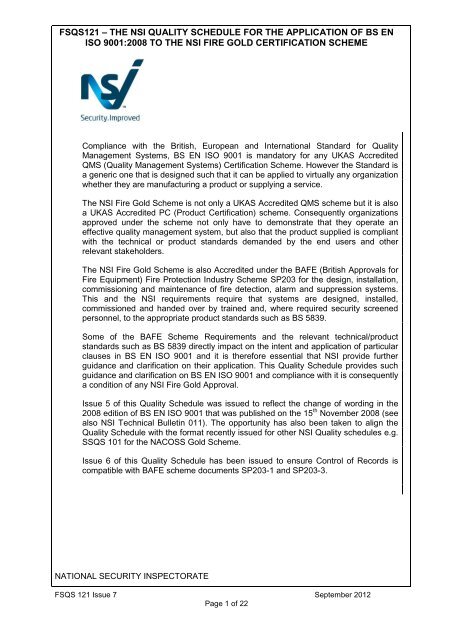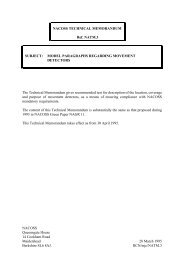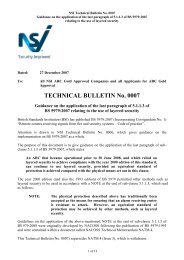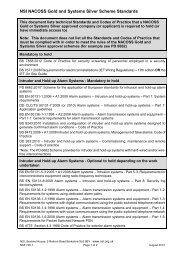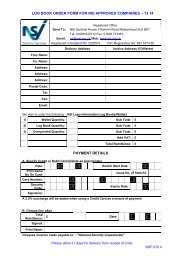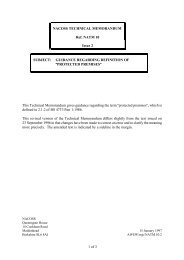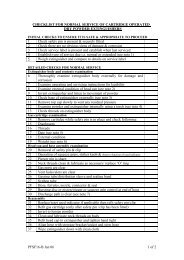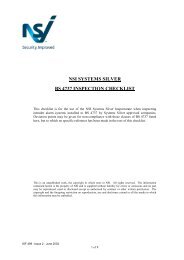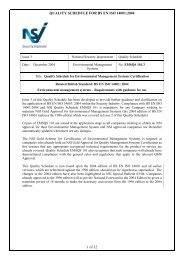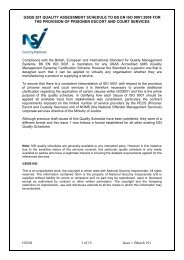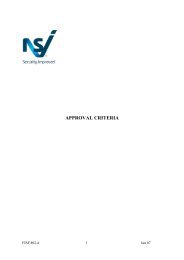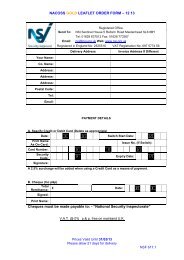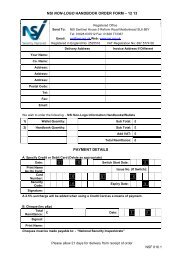NSI Quality Schedule FSQS121
NSI Quality Schedule FSQS121
NSI Quality Schedule FSQS121
You also want an ePaper? Increase the reach of your titles
YUMPU automatically turns print PDFs into web optimized ePapers that Google loves.
<strong>FSQS121</strong> – THE <strong>NSI</strong> QUALITY SCHEDULE FOR THE APPLICATION OF BS EN<br />
ISO 9001:2008 TO THE <strong>NSI</strong> FIRE GOLD CERTIFICATION SCHEME<br />
Compliance with the British, European and International Standard for <strong>Quality</strong><br />
Management Systems, BS EN ISO 9001 is mandatory for any UKAS Accredited<br />
QMS (<strong>Quality</strong> Management Systems) Certification Scheme. However the Standard is<br />
a generic one that is designed such that it can be applied to virtually any organization<br />
whether they are manufacturing a product or supplying a service.<br />
The <strong>NSI</strong> Fire Gold Scheme is not only a UKAS Accredited QMS scheme but it is also<br />
a UKAS Accredited PC (Product Certification) scheme. Consequently organizations<br />
approved under the scheme not only have to demonstrate that they operate an<br />
effective quality management system, but also that the product supplied is compliant<br />
with the technical or product standards demanded by the end users and other<br />
relevant stakeholders.<br />
The <strong>NSI</strong> Fire Gold Scheme is also Accredited under the BAFE (British Approvals for<br />
Fire Equipment) Fire Protection Industry Scheme SP203 for the design, installation,<br />
commissioning and maintenance of fire detection, alarm and suppression systems.<br />
This and the <strong>NSI</strong> requirements require that systems are designed, installed,<br />
commissioned and handed over by trained and, where required security screened<br />
personnel, to the appropriate product standards such as BS 5839.<br />
Some of the BAFE Scheme Requirements and the relevant technical/product<br />
standards such as BS 5839 directly impact on the intent and application of particular<br />
clauses in BS EN ISO 9001 and it is therefore essential that <strong>NSI</strong> provide further<br />
guidance and clarification on their application. This <strong>Quality</strong> <strong>Schedule</strong> provides such<br />
guidance and clarification on BS EN ISO 9001 and compliance with it is consequently<br />
a condition of any <strong>NSI</strong> Fire Gold Approval.<br />
Issue 5 of this <strong>Quality</strong> <strong>Schedule</strong> was issued to reflect the change of wording in the<br />
2008 edition of BS EN ISO 9001 that was published on the 15 th November 2008 (see<br />
also <strong>NSI</strong> Technical Bulletin 011). The opportunity has also been taken to align the<br />
<strong>Quality</strong> <strong>Schedule</strong> with the format recently issued for other <strong>NSI</strong> <strong>Quality</strong> schedules e.g.<br />
SSQS 101 for the NACOSS Gold Scheme.<br />
Issue 6 of this <strong>Quality</strong> <strong>Schedule</strong> has been issued to ensure Control of Records is<br />
compatible with BAFE scheme documents SP203-1 and SP203-3.<br />
NATIONAL SECURITY INSPECTORATE<br />
FSQS 121 Issue 7 September 2012<br />
Page 1 of 22
<strong>FSQS121</strong> – THE <strong>NSI</strong> QUALITY SCHEDULE FOR THE APPLICATION OF BS EN<br />
ISO 9001:2008 TO THE <strong>NSI</strong> FIRE GOLD CERTIFICATION SCHEME<br />
Sentinel House, 5 Reform Road, Maidenhead, Berkshire, SL6 8BY<br />
Telephone: 01628 637512/0845 006 3003 Fax: 01628 773367<br />
1. INTRODUCTION<br />
1.1 <strong>Quality</strong> <strong>Schedule</strong>s are designed specifically for a particular sector of industry<br />
and are used to amplify the requirements of the <strong>Quality</strong> Management System<br />
Standard and thus provide an agreed basis for audit.<br />
1.2 Use of a <strong>NSI</strong> Fire Gold approved organization for Fire detection and Alarm<br />
Systems provides a high level of assurance that:<br />
(a) The Fire Detection and Alarm System has been designed, installed,<br />
commissioned and handed over by trained and, where required security<br />
screened personnel, to the appropriate product standard (such as BS 5839)<br />
and that contractual agreements are fulfilled.<br />
(b) there is a commitment to customer satisfaction and continual business<br />
improvement derived from the implementation of a <strong>Quality</strong> Management<br />
System specifically designed to meet the needs of the Fire Safety Industry,<br />
such needs having been agreed in consultation with insurers, fire & rescue<br />
services, building control, installers, trade associations and professional<br />
institutions.<br />
1.3 The scope of the approved company is detailed by <strong>NSI</strong> on the Certificate of<br />
Approval and is referenced to this <strong>Quality</strong> <strong>Schedule</strong>.<br />
1.4 The International and UKAS guidance associated with the latest edition of BS<br />
EN ISO 9001:2008 permits a two year transition period for organisations<br />
already approved to the 2000 edition and during this transition period <strong>NSI</strong><br />
approved companies may therefore choose to continue working to BS EN ISO<br />
9001:2000 for a limited time. <strong>NSI</strong> will however, encourage existing approved<br />
companies to upgrade to BS EN ISO 9001:2008, as soon as possible. The<br />
transition period expires on 14 th November 2010 after which BS EN ISO<br />
9001:2000 certification will be invalid.<br />
1.5 The transition period does not apply to new applicants for <strong>NSI</strong> Fire Gold<br />
approval and they shall be audited against BS EN ISO 9001:2008 and this<br />
Issue 5 of the <strong>Quality</strong> <strong>Schedule</strong>.<br />
1.6 <strong>NSI</strong> has already issued Technical Bulletin 0011 explaining the general nature of<br />
the changes to the 2008 edition of BS EN ISO 9001 and this <strong>Quality</strong> <strong>Schedule</strong><br />
takes account of the guidance within the Technical Bulletin. Organisations that<br />
address this <strong>Quality</strong> <strong>Schedule</strong> will therefore also generally satisfy the Technical<br />
Bulletin.<br />
1.7 The previous issue of this quality schedule focussed on the fact that since the<br />
2000 edition of BS EN ISO 9001 was issued there has been less emphasis on<br />
documented procedures and more on defining the processes and controlling<br />
the same. The 2008 edition to the standard makes no significant change to this<br />
and it is still relevant to reference the need for only six mandatory procedures.<br />
However, even if the Standard does not require a documented procedure, it<br />
FSQS 121 Issue 7 September 2012<br />
Page 2 of 22
<strong>FSQS121</strong> – THE <strong>NSI</strong> QUALITY SCHEDULE FOR THE APPLICATION OF BS EN<br />
ISO 9001:2008 TO THE <strong>NSI</strong> FIRE GOLD CERTIFICATION SCHEME<br />
may still be the best way to define the process requirements and ensure they<br />
are understood and consistently applied. Note: A documented procedure may<br />
be a detailed written procedure or a simple process flowchart, depending on the<br />
complexity of the process.<br />
2. SCOPE<br />
2.1 This <strong>Quality</strong> <strong>Schedule</strong> is for use on the <strong>NSI</strong> FIRE Gold Scheme and compliance<br />
with the same is a condition of approval.<br />
2.2 This <strong>Quality</strong> <strong>Schedule</strong> sets out the criteria for auditing the <strong>Quality</strong> Management<br />
Systems of organizations engaged in the design, installation, commissioning,<br />
handover and maintenance of Fire Detection & Alarm Systems and does not in<br />
any way diminish the <strong>NSI</strong> Regulations or the defined Scheme Criteria.<br />
2.3 In common with previous practice, this <strong>Schedule</strong> retains the alignment with the<br />
main clause numbers of the BS EN ISO 9001 Standard. Where special<br />
application of the Standard is considered necessary, this is stated.<br />
2.4 Requirements of this <strong>Quality</strong> <strong>Schedule</strong> that must be satisfied are shown in<br />
normal text and are further emphasised by the use of “shall” or “must”. Where<br />
additional guidance is given it is reproduced in italics and often emphasised by<br />
the use of “may” or “can” within the text.<br />
3. OTHER QUALITY SCHEDULES<br />
SSQS 101 for the NACOSS Gold Scheme for organizations engaged in the<br />
design, planning, installation and maintenance of Electronic Security Systems.<br />
SSQS 102 for the <strong>NSI</strong> ARC Gold Scheme.<br />
4. QUALITY SYSTEM REQUIREMENTS<br />
4.1 General<br />
The general requirements for the quality management system set out in clause<br />
4.1 of BS EN ISO 9001: 2008 shall apply.<br />
This includes the requirement to determine the processes needed, their<br />
sequence and interaction, and where applicable how to monitor and measure<br />
them. The 2008 edition now refers to “analysis and improvement” as an actual<br />
process, which supports the view that continual improvement must not just be<br />
as a consequence of actions taken to address non-conformity.<br />
One of the best ways to evidence that all relevant processes have been defined<br />
is to produce an overall flowchart which follows the normal sequence of events.<br />
When determining the processes needed, organizations shall not just address<br />
those carried out in-house but shall clearly define and control those that are<br />
subcontracted or outsourced. It shall also be clear that outsourcing a process<br />
does not absolve the organisation of its responsibility of compliance with all<br />
customer, statutory and regulatory requirements.<br />
FSQS 121 Issue 7 September 2012<br />
Page 3 of 22
<strong>FSQS121</strong> – THE <strong>NSI</strong> QUALITY SCHEDULE FOR THE APPLICATION OF BS EN<br />
ISO 9001:2008 TO THE <strong>NSI</strong> FIRE GOLD CERTIFICATION SCHEME<br />
In principle only the installation module of work can be subcontracted to an<br />
organisation that is in itself not BAFE SP203 Approved for fire detection and<br />
alarm work.<br />
4.2 Documentation requirements<br />
4.2.1 General<br />
No additional requirements apply to this sub-clause of BS EN ISO 9001: 2008<br />
except that the ‘structure’ of the <strong>Quality</strong> Management System shall be clearly<br />
described.<br />
The actual structure of the QMS is left to individual company preference as long<br />
as it can be determined that all clauses of BS EN ISO 9001:2008 and this<br />
<strong>Quality</strong> <strong>Schedule</strong> are clearly addressed. One approach would be to have a slim<br />
line policy manual addressing all clauses that then provides the linkage to the<br />
supporting procedures and process flowcharts which then link to any specific<br />
work instructions and the standard forms to be completed.<br />
The 2008 edition does however include a clarification that a “single document<br />
may address the requirements for one or more procedures and a requirement<br />
for a documented procedure may be covered by more than one document”.<br />
There have been cases in the past where interested parties have taken a view<br />
that for example a separate documented procedure is required for clause 8.3<br />
Control of nonconforming product and clause 8.5.2 Corrective action. The 2008<br />
edition makes it much clearer that this is not the intent and that a combined<br />
procedure is acceptable provided it still effectively addresses both clauses.<br />
4.2.2. <strong>Quality</strong> Manual<br />
The <strong>Quality</strong> Manual shall provide a clear audit trail to supporting<br />
documentation. The justification for any exclusion to the standard shall be<br />
detailed in the <strong>Quality</strong> Manual and although the standard in principle, allows<br />
exclusions to any part of section 7, <strong>NSI</strong> generally find that it is only exclusions<br />
to the Development aspects of clause 7.3 that can be justified (see also section<br />
7.3).<br />
4.2.3 Control of documents<br />
There shall be a documented Procedure for document and data control, which<br />
shall be intended to insure that the latest issues of all relevant documents are<br />
controlled under the <strong>Quality</strong> System.<br />
Within the procedures for document and data control: -<br />
� provision shall be made to list the issue of relevant external documents<br />
including those called up in the <strong>NSI</strong> Regulations and Scheme Criteria,<br />
Fire Service Policies and other applicable Standards, Regulations,<br />
Codes of Practice etc.<br />
FSQS 121 Issue 7 September 2012<br />
Page 4 of 22
<strong>FSQS121</strong> – THE <strong>NSI</strong> QUALITY SCHEDULE FOR THE APPLICATION OF BS EN<br />
ISO 9001:2008 TO THE <strong>NSI</strong> FIRE GOLD CERTIFICATION SCHEME<br />
� provision shall be made to list the issue status of internal documents<br />
pertinent to the company’s own quality management system, including<br />
procedures and any process flow-charts.<br />
� if documents and records are held electronically, the following<br />
safeguards and protocols shall be observed: -<br />
4.2.4 Control of records<br />
a) where a document includes a customer signature, the document<br />
shall be held electronically as a facsimile copy, including a<br />
facsimile copy of the signature.<br />
alternatively, traceability from a customer signature on a hard<br />
copy to an electronically held record will be acceptable. Where<br />
documents held electronically require authorisation (say<br />
customer specification) then issue status must be allocated and<br />
access rights controlled by password entry at appropriate levels<br />
of authorisation.<br />
Where a Firm introduces other arrangements, it shall be required<br />
to demonstrate that the above principles of authorisation and<br />
agreement are upheld.<br />
b) reasonable and secure backup arrangements shall be in place,<br />
and shall be strictly adhered to.<br />
c) backup records shall be securely held (preferably in a fire<br />
resistant container or off-site).<br />
d) there shall be ready access to the information for the purpose of<br />
<strong>NSI</strong> inspection/assessment/surveillance, etc.<br />
Note: It is the responsibility of the Company to determine whether<br />
specific contractual documents are legally required to be<br />
originals.<br />
A documented Procedure shall be established which defines the controls<br />
needed for identification, storage, protection, retrieval, retention time and<br />
disposition of the quality records developed to provide evidence of<br />
conformance and effective operation of the <strong>Quality</strong> Management System.<br />
Records in respect of Contracts (including survey, design, quotations,<br />
installation, commissioning, verification, handover, modification and ‘as fitted<br />
drawings’) shall be maintained and made readily accessible for a minimum of<br />
12 years from the date of handover or until some other organisation, e.g. the<br />
owner of the installation formally takes responsibility for their ongoing storage<br />
and maintenance,<br />
System records for maintenance, disconnection, historical and false alarm<br />
records shall be held for the life of the contract plus a minimum of two (2) years,<br />
except where permitted otherwise in the relevant product standard.<br />
For security screening records see clause 6.2.3<br />
FSQS 121 Issue 7 September 2012<br />
Page 5 of 22
<strong>FSQS121</strong> – THE <strong>NSI</strong> QUALITY SCHEDULE FOR THE APPLICATION OF BS EN<br />
ISO 9001:2008 TO THE <strong>NSI</strong> FIRE GOLD CERTIFICATION SCHEME<br />
5. MANAGEMENT RESPO<strong>NSI</strong>BILITY<br />
5.1 Management commitment<br />
No additional requirements apply to this sub-clause of BS EN ISO 9001: 2008.<br />
5.2 Customer focus<br />
No additional requirements apply to this sub-clause of BS EN ISO 9001: 2008<br />
5.3 <strong>Quality</strong> policy<br />
In addition to the requirements to this sub-clause of BS EN ISO 9001: 2008 the<br />
Policy Statement shall include a commitment to comply with this <strong>Quality</strong><br />
<strong>Schedule</strong>, an intention to meet industry agreed Codes of Practice, any relevant<br />
product standards and applicable legal requirements.<br />
Accredited certification bodies for any management systems certification now<br />
have to comply with a new generation of standards that increasingly take the<br />
view that organisations should not be approved if there are any breaches of<br />
applicable legislation. This is reflected in the introduction to BS EN ISO<br />
9001:2008 where use of the Standard now includes assessment of an<br />
organisations ability to meet statutory requirements applicable to the product<br />
(also expressed as legal requirements).<br />
<strong>NSI</strong>, as a UKAS (United Kingdom Accreditation Service) Accredited<br />
Certification Body shall not recommend approval to BS EN ISO 9001:2008 if<br />
there are known breaches of legal requirements that directly relate to the<br />
product or service provided.<br />
Organisations wishing to obtain or maintain <strong>NSI</strong> Approval under the <strong>NSI</strong> Fire<br />
Gold Scheme shall include a commitment in their Policy Statement that it is<br />
their intent to comply with applicable legal requirements and periodically<br />
evaluate compliance with the same as an input to management review.<br />
Appropriate management shall also demonstrate that they are generally aware<br />
of the prime legislation that impinges on their area of responsibility and<br />
authority.<br />
For example if an operations manager deploying installation engineers had no<br />
understanding that there was any legislation that relates to working at height<br />
and was not aware of his health & safety obligations then it could hardly be<br />
argued that he is competent to perform his duties and it would not only be an<br />
issue in terms of potential legal nonconformity but also in terms of clause 6.2.2<br />
Competence, training and awareness.<br />
For companies who are also incorporating the requirements of the BAFE<br />
Scheme Document SP 203 the Policy Statement must also include a reference<br />
to the modules of work that the quality management system covers.<br />
5.4 Planning<br />
5.4.1 <strong>Quality</strong> objectives<br />
FSQS 121 Issue 7 September 2012<br />
Page 6 of 22
<strong>FSQS121</strong> – THE <strong>NSI</strong> QUALITY SCHEDULE FOR THE APPLICATION OF BS EN<br />
ISO 9001:2008 TO THE <strong>NSI</strong> FIRE GOLD CERTIFICATION SCHEME<br />
No additional requirements apply to this sub-clause of BS EN ISO 9001: 2008.<br />
5.4.2 <strong>Quality</strong> management system planning<br />
As detailed in the standard.<br />
Examples of situations where changes to the quality management system are<br />
to be considered are: -<br />
- Acquisitions and joint ventures<br />
- Introduction of new technologies.<br />
- Organisational restructuring<br />
- The use of sub-contractors<br />
5.5 Responsibility, authority and communication<br />
5.5.1 Responsibility and authority<br />
As detailed within the Standard, responsibilities and authorities shall be defined<br />
and communicated within the organisation.<br />
Key factors in determining how such responsibilities and authorities shall be<br />
defined will be the size and complexity of the organisation.<br />
In a large organisation with all sorts of departmental interfaces then it shall<br />
either be through documented job descriptions, a schedule of key personal<br />
responsibilities in the quality manual and/or inclusion within the documented<br />
procedures. In a very small family run organisation provided management and<br />
staff demonstrate on interview a common understanding of everyone’s prime<br />
responsibilities and authorities, it may not be necessary to have them<br />
documented to the same extent.<br />
The <strong>NSI</strong> Fire Gold Scheme specifically requires that certain responsibilities and<br />
authorities are clearly assigned i.e.<br />
- for the ‘Nominated Designer(s)’ see Clause 7.3 Design<br />
- for any ‘Nominated Design Technician(s)’ see Clause 7.3 Design<br />
- for the Systems Performance Executive(s) – SPE<br />
The Nominated Designer(s) is responsible for authorising all fire system<br />
designs and the SPE is responsible for all aspects of fire system performance<br />
such as the monitoring and analysis of unwanted fire alarms and troublesome<br />
fire systems.<br />
5.5.2 Management representative<br />
As detailed within the Standard, but the 2008 edition now states that the<br />
management representative appointed by top management must be a member<br />
of the organisation’s management.<br />
FSQS 121 Issue 7 September 2012<br />
Page 7 of 22
<strong>FSQS121</strong> – THE <strong>NSI</strong> QUALITY SCHEDULE FOR THE APPLICATION OF BS EN<br />
ISO 9001:2008 TO THE <strong>NSI</strong> FIRE GOLD CERTIFICATION SCHEME<br />
This makes it much clearer that it is not normally acceptable to appoint a<br />
subcontract quality consultant as the management representative unless there<br />
is a clear on-going contract which gives him/her the necessary responsibilities<br />
and authorities required by clause 5.5.2 and for all practical purposes they are<br />
almost regarded as a part-time employee.<br />
5.5.3 Internal Communication<br />
No additional requirements apply to this sub-clause of BS EN ISO 9001:2008.<br />
5.6 Management review<br />
5.6.1 General<br />
The general requirements set out in clause 5.6.1 of BS EN ISO 9001:2008 shall<br />
apply.<br />
<strong>NSI</strong> recognise that there are sometimes different views as to who are the top<br />
management personnel who should carry out the review. Each case has to be<br />
reviewed on its own merit, particularly in large multi-layered PLC’s.<br />
It also may not be practicable or necessary for all Directors to be present at the<br />
management review meetings, if and when interviewed on actual audit, they<br />
can demonstrate awareness of significant issues raised at the meetings.<br />
5.6.2 Review input<br />
The Management Review Agenda shall be determined by top management and<br />
shall include, but not be limited to, the following items as appropriate to the<br />
types of fire detection and alarm systems installed:<br />
� follow up actions from previous management reviews<br />
� the results from internal and external audits (administrative and<br />
technical)<br />
� unwanted fire alarm performance and trends<br />
� routine maintenance – monthly performance and trends<br />
� response to emergency call out – performance and trends<br />
� customer satisfaction (including complaints)<br />
� resources<br />
� training needs<br />
� status of preventative and corrective actions and their effectiveness.<br />
� performance of subcontractors (including alarm receiving centres)<br />
� planned changes that could effect the quality management system<br />
� continual improvement initiatives<br />
FSQS 121 Issue 7 September 2012<br />
Page 8 of 22
<strong>FSQS121</strong> – THE <strong>NSI</strong> QUALITY SCHEDULE FOR THE APPLICATION OF BS EN<br />
ISO 9001:2008 TO THE <strong>NSI</strong> FIRE GOLD CERTIFICATION SCHEME<br />
5.6.3 Review output<br />
� adequacy of <strong>Quality</strong> Policy<br />
� adequacy of <strong>Quality</strong> Objectives<br />
� new legislation (when appropriate)<br />
� infrastructure (when appropriate)<br />
� new technology (when appropriate)<br />
� evaluation of legal compliance<br />
No additional requirements apply to this sub-clause of BS EN ISO 9001:2008.<br />
6. RESOURCE MANAGEMENT<br />
6.1 Provision of resources<br />
No additional requirements apply to this sub-clause of BS EN ISO 9001:2008.<br />
6.2 Human resources<br />
6.2.1 General<br />
The general requirements for human resources set out in clause 6.2.1.of BS EN<br />
ISO 9001:2008 shall apply i.e. that personnel performing conformity to product<br />
requirements shall be competent on the basis of appropriate education,<br />
training, skills and experience.<br />
It is not the intention of <strong>NSI</strong> to be too prescriptive regarding how such<br />
competency should be demonstrated, but this and the following clause suggest<br />
that it is useful in most organisations to develop job descriptions for each<br />
identified role and include in them a so-called person or job specification which<br />
can detail the required level of qualifications, experience, skills, attributes etc<br />
that an ideal incumbent should have. Reviewing candidates against the person<br />
or job specification can then enable an organisation to demonstrate that it does<br />
take care to recruit the right people for each identified role in the organisation.<br />
6.2.2 Competence, awareness and training<br />
It is worth emphasising that organizations “shall determine the necessary<br />
competence for all personnel performing work affecting conformity to product<br />
requirements and where applicable, provide training or take other actions to<br />
achieve the necessary competence.<br />
The quoted clause now makes it much clearer that competency is not simply<br />
achieved just by providing some training. The fact that someone receives<br />
training does not guarantee that they will thereafter demonstrate competency in<br />
carrying out their duties.<br />
Again it is not the intent of <strong>NSI</strong> to be too prescriptive, but it is suggested that<br />
organisations should consider a probationary period for all new employees and<br />
formally review their competency before granting confirmed employment.<br />
FSQS 121 Issue 7 September 2012<br />
Page 9 of 22
<strong>FSQS121</strong> – THE <strong>NSI</strong> QUALITY SCHEDULE FOR THE APPLICATION OF BS EN<br />
ISO 9001:2008 TO THE <strong>NSI</strong> FIRE GOLD CERTIFICATION SCHEME<br />
The objective here is to identify and address any areas where their competency<br />
is not immediately indicated and which could indicate a need for further<br />
training/development. Thereafter, there needs to be a process of verifying ongoing<br />
competency which could include feedback from internal and external<br />
audit, formal staff appraisal/evaluation etc.<br />
Organisations shall clearly define and document their process(es) for<br />
determining both initial and on-going competency and ensure that such<br />
processes are subject to periodic internal audit.<br />
In determining and being able to demonstrate the availability of the necessary<br />
competence within the Company it will still be relevant to establish a training<br />
programme that should be in operation that includes, where relevant: -<br />
� surveying skills<br />
� installation skills<br />
� inspection and test skills (commissioning and handover)<br />
� maintenance and service skills<br />
� quality procedures and/or documentation appropriate to the<br />
business processes<br />
� company standards for quality and control over requirements<br />
� internal auditing skills<br />
Training records shall be available for review and shall demonstrate the<br />
effective operation of the above programme and the signature of the person<br />
who has received the training.<br />
Training records shall include evidence to substantiate that staff have the<br />
technical capability to work upon the equipment or systems used.<br />
Note: - It is not mandatory for personnel to attend external training courses.<br />
However, it is recommended that certain personnel do attend such courses if<br />
the Company, as a whole, does not possess the necessary skills in a given<br />
area.<br />
6.2.3 Security Screening (An additional requirement of this <strong>Quality</strong> <strong>Schedule</strong>.)<br />
Companies shall adopt a documented policy statement in relation to the<br />
security screening of personnel who visit customer’s premises for the purpose<br />
of selling, designing, installing, commissioning, handover or monitoring fire<br />
detection and alarm systems or who have access to confidential information<br />
regarding such systems or the premises in which such systems are installed or<br />
are to be installed. The documented policy statement should cover staffpersonnel<br />
and also sub-contract personnel. A copy should be available to<br />
customers and prospective customers on request.<br />
The Fire Scheme is not prescriptive as to the content of the policy statement.<br />
However, it should be clear to a reader of the policy statement whether or not<br />
the Company ensures that all personnel visiting customer’s premises or having<br />
FSQS 121 Issue 7 September 2012<br />
Page 10 of 22
<strong>FSQS121</strong> – THE <strong>NSI</strong> QUALITY SCHEDULE FOR THE APPLICATION OF BS EN<br />
ISO 9001:2008 TO THE <strong>NSI</strong> FIRE GOLD CERTIFICATION SCHEME<br />
access to confidential information are security screened in accordance with BS<br />
7858.<br />
The Company’s internal procedures and practices shall ensure that any<br />
contractual obligations regarding use of security screened personnel are met.<br />
6.3 Infrastructure<br />
No additional requirements apply to this sub-clause of BS EN ISO 9001:2008.<br />
6.4 Work environment<br />
No additional requirements apply to this sub-clause of BS EN ISO 9001:2008,<br />
but is worth emphasising that the term “work environment” now relates to<br />
conditions under which work is performed including physical, environmental and<br />
other factors (such as noise, temperature, humidity, lighting or weather).<br />
In some instances specific aspects of legislation may apply and if there are any<br />
areas of nonconformity with regard to applicable legislation; <strong>NSI</strong> Approval will<br />
not normally be granted.<br />
7. PRODUCT REALISATION<br />
7.1 Planning of product realisation<br />
Processes for the design, installation, commissioning & handover, verification<br />
and maintenance of fire detection and alarm systems shall be developed to<br />
take into account the need to integrate the technical and regulatory requirement<br />
of the fire industry with the requirements of the quality management system.<br />
The extent and form of the documentation required shall take account of the<br />
need to provide evidence:-<br />
� that contractual obligations are agreed and understood by all parties.<br />
� that system design specifications and drawings reflect the level of life<br />
safety and/or building protection required.<br />
� of the competency of staff<br />
� the components used on installations meet the technical requirements<br />
of the industry.<br />
� of in-process, commissioning and handover inspections including<br />
regulatory handover and maintenance documentation.<br />
� of adequate planning and monitoring of installation work and<br />
commissioning work including project management techniques where<br />
appropriate.<br />
� of adequate administrative and technical support to installation<br />
personnel on site.<br />
� of the appropriate level of on-site supervision, particularly on long<br />
running contracts.<br />
FSQS 121 Issue 7 September 2012<br />
Page 11 of 22
<strong>FSQS121</strong> – THE <strong>NSI</strong> QUALITY SCHEDULE FOR THE APPLICATION OF BS EN<br />
ISO 9001:2008 TO THE <strong>NSI</strong> FIRE GOLD CERTIFICATION SCHEME<br />
Companies are reminded that activities for process control must be<br />
consistent with the specified requirements for Fire Detection and Alarm<br />
Systems. Typical documents that can apply for FD&A systems are BS 5839<br />
Parts 1 & 6 (Pt 8 for Voice Alarms), BS 6266, relevant HTM-0503 Technical<br />
Memorandum (e.g. for hospitals and care residences) etc.<br />
The requirements set out in European Standards will apply when called up<br />
by the contract or additionally advised by <strong>NSI</strong>.<br />
7.2 Customer-related processes<br />
The formal contract review process is set out below. Service Providers are<br />
reminded that associated practices in respect of the agreement for the system<br />
design specification are set out in clause 7.3.<br />
For guidance relevant requirements may be found in the British Standards<br />
associated with FD&A systems such as BS 5839 and BS 6266.<br />
(a) General<br />
The identity of the persons allocated responsibility and authority to carry<br />
out contract reviews shall be clearly defined and communicated within<br />
the Approved Company (sub clause 5.5.1. of BS EN ISO 9001:2008<br />
refers).<br />
(b) Review<br />
Contract reviews shall be undertaken: -<br />
(i) Before submission of any tender or quotation, to confirm that the<br />
requirements are adequately defined and documented and that the<br />
Company has the capability and resources to meet the<br />
requirements.<br />
(ii) After receipt of the customer’s reply to any tender or quotation, or on<br />
receipt of a purchase order, to ensure that any changes requested<br />
by the customer can be satisfied.<br />
There shall be evidence, by means such as stamp or signature, of all<br />
contract reviews.<br />
Organisations shall make clear in appropriate documentation whether or<br />
not they accept verbal confirmation of orders and, if so, policy shall<br />
require the Company to send a written statement to the customer stating<br />
its understanding of the agreement and confirming that this will be taken<br />
as the agreement unless the customer notifies otherwise in writing.<br />
(c) Amendment to contract<br />
Procedures shall require the Organisations, on completion of the<br />
installation (or their module of the work), to ensure that all amendments<br />
are agreed, recorded and authorised and that the requirements of the<br />
contract (including, if appropriate, a remote signalling connection and<br />
notifications to third parties) are completed.<br />
(d) Records<br />
FSQS 121 Issue 7 September 2012<br />
Page 12 of 22
<strong>FSQS121</strong> – THE <strong>NSI</strong> QUALITY SCHEDULE FOR THE APPLICATION OF BS EN<br />
ISO 9001:2008 TO THE <strong>NSI</strong> FIRE GOLD CERTIFICATION SCHEME<br />
Records of contract reviews shall be held for the life of the contract plus<br />
two (2) years. (See also Clause 4.2.4 of BS EN ISO 9001:2008).<br />
Note: Certain contract information may need to be held for longer<br />
periods to satisfy relevant authorities e.g. HM Revenue & Customs.<br />
(e) Customer liaison<br />
Effective customer liaison shall be continued through the life of the<br />
contract.<br />
The 2008 edition of BS EN ISO 9001 under clause 7.2.1 makes it clear that<br />
statutory and regulatory requirements shall be determined and a new Note in<br />
the Standard references that supplementary services such as recycling or final<br />
disposal are post delivery activities and shall also be considered.<br />
With any Accredited Management System Certification there is increasing<br />
recognition that Certification ought to give a level of assurance that the<br />
approved organisation is aware of relevant legislation and that it is essentially<br />
compliant. The reference to recycling or final disposal is a useful pointer to the<br />
increasing raft of environmental legislation that applies to organizations whether<br />
or not they choose to implement an Environmental Management System. For<br />
example electronic and electrical equipment can no longer be sent to land fill<br />
(the WEEE Regulations apply) and manufacturers of certain types of equipment<br />
are obliged to have or participate in a take back scheme for the old equipment.<br />
It is strongly recommended that organisations should maintain a consolidated<br />
list of the prime legislation that they believe is relevant to their organisation<br />
(see also clause 5.3).<br />
7.3 Design<br />
The detailed selection, placement and configuration of products and the<br />
interconnection to meet the specified requirements for a particular fire detection<br />
and alarm system are considered to be application design rather than<br />
conceptual design (i.e. development design). For this reason the word<br />
‘development’ has been excluded from the sub-headings of this section on<br />
design (and therefore differs in this respect from the corresponding clauses in<br />
BS EN ISO 9001).<br />
7.3.1 Design planning<br />
Note 1: In the case of FD&A systems attention is drawn to British Standard<br />
Code of Practice BS 5839: Part 1: 2002 and in particular to Section<br />
2 Design Considerations. Where other British Standards or Industry<br />
Codes of Practice are to be called up, within the contract, those<br />
relevant design requirements shall be considered.<br />
Note 2: Design Planning arrangements differing from those set out in 7.3.1<br />
below will be considered by <strong>NSI</strong> for any company wishing to adopt<br />
differing arrangements, provided there is evidence that the<br />
arrangements adopted ensure that the provisions of BS EN ISO<br />
9001:2008 and the relevant technical and other standards, Codes of<br />
Practice, regulatory requirements etc., are met. Any Company<br />
wishing to adopt alternative arrangement should write to the <strong>NSI</strong><br />
office giving details.<br />
a) Controls shall be established to ensure that:<br />
FSQS 121 Issue 7 September 2012<br />
Page 13 of 22
<strong>FSQS121</strong> – THE <strong>NSI</strong> QUALITY SCHEDULE FOR THE APPLICATION OF BS EN<br />
ISO 9001:2008 TO THE <strong>NSI</strong> FIRE GOLD CERTIFICATION SCHEME<br />
� the appropriate stages of system design specification<br />
development (viz. design planning, design inputs, design<br />
outputs, design review, design verification, design validation,<br />
and control of design changes; see 7.3 of BS EN ISO<br />
9001:2008) are followed.<br />
� the customer is made aware of and agrees to any other<br />
limitations (if any) of the demands of the appropriate<br />
technical standard and regulatory requirements of other<br />
interested parties (e.g. local building control authority, fire<br />
brigade officers, insurers).<br />
� the customer is made aware of and agrees to any other<br />
limitations of the design (or to the proposed design) in terms<br />
of adequacy of detection/control and warning/signalling<br />
capability.<br />
� the requirements of the customer are translated into a<br />
system design specification that is appropriate to the<br />
premises (or site) where the fire detection and alarm system<br />
is to be installed and that lists the equipment and<br />
components to be supplied, detailing their proposed<br />
locations and containing a general indication of their<br />
coverage and purpose.<br />
� the system design specification contains within it a Design<br />
Statement, which includes information on any limitations to<br />
the design in terms of adequacy of detection/control and<br />
warning/signalling capability. (Alternatively, the Design<br />
Statement may be a separate document, provided it is<br />
clearly referenced within the system design specification).<br />
� there is consideration of any variations and amendments in<br />
the customer requirements as installation proceeds (or<br />
arising from practicalities coming to notice as installation<br />
proceeds) and the recording of such variations or<br />
amendments between customer and the Company, in the<br />
system design specification, or in properly issued<br />
amendments to the system design specification, or in an “as<br />
fitted system record.<br />
Note: The “as fitted” system record shall include an “as<br />
fitted” drawing and, where appropriate, to scale.<br />
Agreed variations (agreed by the customer with the<br />
Company) to the requirements of the relevant<br />
standard (e.g. BS 5839) shall be documented as a<br />
list.<br />
(b) In discharging its responsibility (see 7.3.1 of BS EN ISO 9001:2008) to<br />
define the responsibilities and authorities for design and to manage the<br />
Interfaces between different groups involved in design:<br />
(1) The Company shall designate one or more suitably competent<br />
individual(s) as “Nominated Designer(s)”.<br />
(2) Each individual designated by the Company as a “Nominated<br />
Designer” shall be competent to undertake the tasks that<br />
include: -<br />
FSQS 121 Issue 7 September 2012<br />
Page 14 of 22
<strong>FSQS121</strong> – THE <strong>NSI</strong> QUALITY SCHEDULE FOR THE APPLICATION OF BS EN<br />
ISO 9001:2008 TO THE <strong>NSI</strong> FIRE GOLD CERTIFICATION SCHEME<br />
(i) Acting as the focal point for matters of the design of the fire<br />
system.<br />
(ii) Assessing the fire risk factors (for example relating to<br />
adequacy of detection/control and warning/evacuation and<br />
signalling capability influencing the design).<br />
(iii) Being conversant with the products and systems specified,<br />
and with any significant limitations inherent in such products<br />
and systems.<br />
(iv) Ensuring that the content of quotations and system design<br />
specifications is compatible with the requirements of the<br />
applicable Technical Standards, and <strong>NSI</strong> Gold Codes of<br />
Practice.<br />
(v) “Signing Off” designs on behalf of the Company.<br />
(vi) Being conversant with installation requirements such that<br />
system design specifications are professionally compiled and<br />
finalised in a manner, which gives clear and unambiguous<br />
information to the customer and to the technicians who install<br />
and commission.<br />
Note; There should be evidence that “Nominated Designers” are willing<br />
to seek advice and guidance as required from other companies<br />
(such as equipment manufacturers) and organisations, and to<br />
develop and to keep up to date their skills by such means as<br />
reading fire magazines and journals, attending conferences and<br />
workshops.<br />
(3) The Company may choose to designate one or more suitably<br />
competent individual(s) as “Nominated Design” Technician(s).<br />
(4) In respect to all functions relevant to the design process (but not<br />
necessarily in respect to his/her other functions) each individual<br />
designated as a “Nominated Design Technician” shall be<br />
responsible to and shall work under the authority and<br />
supervision of a “Nominated Designer”.<br />
(5) Each individual designated by the Company as a “Nominated<br />
Design Technician” shall be competent (within the range of<br />
type(s) of work where he/she acts as a “Nominated Design<br />
Technician”) to undertake tasks that include those listed in (ii),<br />
(iii), (iv), (v) and (vi) of 7.3.1. (b)(2) above, except that<br />
competence in respect of (vi) is not necessary where there is<br />
evidence that the effects of new technologies, technical<br />
standards, national implementation of EU Directives, etc.<br />
relevant to the design processes of the Company have been<br />
adequately considered by a “Nominated Designer” and evidence<br />
that the constraints within which the “Nominated Design<br />
Technician” operates are such as to ensure that these matters<br />
are adequately taken into account in the designs prepared<br />
and/or “signed off” by the “Nominated Design Technician”.<br />
(b) In all cases, a site survey (preferably at initial enquiry stage, or at some<br />
other stage, prior to issue of a quotation and system design proposal, but<br />
always at a stage prior to actual commencement of installation) shall be<br />
undertaken by a “Nominated Designer” or by a “Nominated Design<br />
FSQS 121 Issue 7 September 2012<br />
Page 15 of 22
<strong>FSQS121</strong> – THE <strong>NSI</strong> QUALITY SCHEDULE FOR THE APPLICATION OF BS EN<br />
ISO 9001:2008 TO THE <strong>NSI</strong> FIRE GOLD CERTIFICATION SCHEME<br />
Technician”. Final “sign off” on behalf of the Company of a system design<br />
proposal shall not occur until such a site survey has been completed.<br />
Note. This sub paragraph would not apply to new builds on green or brown<br />
field sites. It applies to retrofit to existing buildings.<br />
7.3.2 Design inputs<br />
No additional requirements apply to this sub-clause of BS EN ISO<br />
9001:2008.<br />
7.3.3 Design outputs<br />
No additional requirements apply to this sub clause of BS EN ISO<br />
9001:2008<br />
7.3.4 Design Review<br />
No additional requirements apply to this sub-clause of BS EN ISO<br />
9001:2008<br />
7.3.5 Design verification<br />
Throughout the installation, commissioning and handover process the<br />
original design and any subsequent changes to that original design must be<br />
verified in order that the completed FD&A system is confirmed as fit for<br />
purpose. This must be an ongoing process for systems contracted to one<br />
Company or for systems contracted to more than one Company (i.e. a<br />
modular approach). In the latter scenario the person or organisation<br />
responsible for verification should be identified at the commencement of the<br />
installation work.<br />
7.3.6. Design validation<br />
Commissioning and handover will fulfil this requirement.<br />
7.3.7. Control of design changes<br />
7.4 Purchasing<br />
No additional requirements apply to this sub-clause of BS EN ISO<br />
9001:2008 but control will be closely associated to design verification.<br />
Activities associated with tasks or services that are subcontracted shall be<br />
consistent with the requirements of <strong>NSI</strong> Gold Code of Practice NACP 3 including<br />
those for security screening (guidelines for security screening are to be found at<br />
6.2.3.)<br />
Component and equipment repairs shall be carried out in accordance with the UK<br />
Regulations covering Electromagnetic Compatibility and then only by the<br />
component manufacturer, by his appointed repair agent, or by a facility that has<br />
been satisfactorily assessed against BS EN ISO 9001 (or an equivalent<br />
specification) by a recognised third party certification body.<br />
7.5 Production and service provision<br />
7.5.1 Control of production and service provision<br />
(a) No additional requirements apply to this sub-clause of BS EN ISO<br />
9001:2008 (but see specific requirements for Service Provision below)<br />
FSQS 121 Issue 7 September 2012<br />
Page 16 of 22
<strong>FSQS121</strong> – THE <strong>NSI</strong> QUALITY SCHEDULE FOR THE APPLICATION OF BS EN<br />
ISO 9001:2008 TO THE <strong>NSI</strong> FIRE GOLD CERTIFICATION SCHEME<br />
Note: Companies are reminded that electrical wiring and installation<br />
must be in accordance with good safety practice and in<br />
compliance with applicable standards and regulations (see the<br />
Scheme Criteria).<br />
(b) Service provision<br />
Companies are reminded that servicing (i.e. maintenance) must be<br />
carried out in accordance with published requirements (e.g. for fire<br />
detection and alarm systems, BS 5839: Part 1: Clause 45)<br />
There shall be provision for adequate administrative and technical<br />
support to service personnel.<br />
For component repairs see 7.4 of this schedule.<br />
The following specific requirements apply to servicing (i.e. maintenance)<br />
of fire detection and alarm systems). The following processes are also<br />
applicable to the Maintenance Module (as understood by the BAFE<br />
SP203 Scheme Document).<br />
(i) Corrective maintenance<br />
For fire detection and alarm systems there shall be a documented<br />
process for false fire alarm management. This process shall identify<br />
provisions for escalating response; the identification and resolution<br />
of troublesome systems; the ongoing performance review by the<br />
Systems Performance Executive; and the following requirements: -<br />
� There shall be a record of the date and time of receipt of every<br />
emergency call, together with the date and time of the engineer’s<br />
arrival and the completion of any necessary corrective action. This<br />
information shall be kept (for at least two years) after the event to<br />
which it refers and the customer provided with a copy.<br />
� Authorisation from the customer for any temporary disconnection<br />
shall be kept for at least (3) months after reconnection.<br />
� There shall be adequate access to spares at all times.<br />
� The Company shall audit technician’s holdings of spares to ensure<br />
continued adequate provision (see also 8.2.2. of this <strong>Quality</strong><br />
<strong>Schedule</strong>)<br />
(ii) Preventative maintenance<br />
There shall be a documented process for the planning, scheduling<br />
and implementation of preventative maintenance and also for the<br />
review of preventative maintenance performance.<br />
Attention is drawn to the recommendations contained in <strong>NSI</strong><br />
Technical Memorandum NATM. 7 “Guidelines Concerning Routine<br />
Maintenance Performance of Installers/Maintainers of Intruder<br />
Alarms. This document will be reissued, in due course, to include<br />
Maintainers of Fire Detection and Alarm Systems.<br />
7.5.2 Validation of processes for production and service provision<br />
There shall be a defined process for “in-process inspection” (e.g. during<br />
commissioning) and “final inspection and testing” (e.g. at handover) and<br />
FSQS 121 Issue 7 September 2012<br />
Page 17 of 22
<strong>FSQS121</strong> – THE <strong>NSI</strong> QUALITY SCHEDULE FOR THE APPLICATION OF BS EN<br />
ISO 9001:2008 TO THE <strong>NSI</strong> FIRE GOLD CERTIFICATION SCHEME<br />
shall be consistent with the requirements of the appropriate British<br />
Standard(s) (e.g. BS 5839) and <strong>NSI</strong> Codes of Practice (e.g. NACP 2) and<br />
with specific contract requirements.<br />
The following processes are also applicable to the “commissioning and<br />
handover module”, (as outlined in the BAFE SP203 Scheme Document).<br />
Commissioning engineers are required to have a good working knowledge<br />
of the design of fire detection and alarm systems in order that design<br />
verification can be carried out during the commissioning process.<br />
Particular attention must be given to the issue of the <strong>NSI</strong>/BAFE Certificate<br />
of Compliance, Modular Certificates of Compliance and Modification<br />
Certificates of Compliance. The criteria for issue can be found on the<br />
certificate and the inside cover accompanying the book of blank certificates,<br />
issued to Companies.<br />
Documentation related to the inspection and test status of fire detection and<br />
alarm systems shall include and provide information as follows: -<br />
� The “as fitted drawings” preferably to scale.<br />
� Loop resistance and cable insulation readings<br />
� Theoretical standby battery capacity calculations together with the<br />
verified current readings taken at commissioning.<br />
� Sounder audibility readings.<br />
� Cause and effect verification checks – to include call point/detector<br />
operation, staged evacuation requirements, shutdowns such as<br />
HVAC, gas, plant, lifts etc.<br />
� Customer log books.<br />
� M & E Manuals where appropriate.<br />
� A zone diagram located adjacent to the main control unit.<br />
7.5.3 Identification and traceability<br />
A system of uniquely identifying equipment and documentation shall be<br />
maintained to minimise the potential for miss-filing and ensure documentation<br />
in relation to each contract and the QMS can be readily achieved.<br />
Unless special contractual conditions are imposed by customers, processes<br />
shall reflect the extent of traceability of components required for the Company’s<br />
own purposes, such as for reasons of warranty etc.<br />
All staff who regularly come into contact with clients and their representatives<br />
shall carry an identity card or other equivalent means of identification. Such<br />
identity cards shall as a minimum include a current photograph of the individual,<br />
the name of the organization represented and a contact telephone number for<br />
verification purposes.<br />
Dependent upon the client base and the type of sites visited the organization<br />
may also need to consider incorporating additional information on their identity<br />
cards i.e. issue and expiry dates, signature etc and have clearly defined<br />
procedures to recover identity cards from leavers etc.<br />
FSQS 121 Issue 7 September 2012<br />
Page 18 of 22
<strong>FSQS121</strong> – THE <strong>NSI</strong> QUALITY SCHEDULE FOR THE APPLICATION OF BS EN<br />
ISO 9001:2008 TO THE <strong>NSI</strong> FIRE GOLD CERTIFICATION SCHEME<br />
7.5.4 Customer property<br />
Processes for the takeover of installations shall be consistent with the<br />
requirements of <strong>NSI</strong> Directive NAD 3 “Rules relating to the issue of <strong>NSI</strong><br />
certificates of compliance and related matters”.<br />
In addition to this Companies must hold an appropriate “Scope of Approval” (in<br />
respect to the BAFE Scheme) before a <strong>NSI</strong>/BAFE certificate can be issued. The<br />
BAFE Scheme Document should be read to identify the Scheme’s requirements<br />
on this subject.<br />
The 2008 edition now also includes a useful note to remind organizations that<br />
‘customer property can include intellectual and personal data’.<br />
7.5.5 Preservation of product<br />
No additional requirements apply to this sub-clause of BS EN ISO 9001:2008. It<br />
is important, however, that manufacturers’ instructions are followed particularly<br />
in relation to the use of batteries and to the use of electronic components that<br />
are sensitive to electrostatic charge. The “first in, first out” system of stock<br />
control is recommended for batteries etc.<br />
7.6 Control of monitoring and measuring devices<br />
No additional requirements apply to this sub-clause of BS EN ISO 9001:2008<br />
8 MEASUREMENT, ANALYSIS AND IMPROVEMENT<br />
8.1 General<br />
The general requirements set out in Clause 8.1 of BS EN ISO 9001:2008 shall<br />
apply. Other clauses are qualified as follows: -<br />
8.2 Monitoring and measurement<br />
The performance of the quality management system shall be measured through<br />
the monitoring of the following aspects: -<br />
8.2.1 Customer satisfaction<br />
Sources of customer perception could include: -<br />
� the outcome of customer satisfaction surveys<br />
� the number of sales arising from recommendations<br />
� the number of installations taken over by competitors<br />
� letters of recommendation received from satisfied customers<br />
� contract retention<br />
� trends in false alarm performance<br />
� other sources as determined by the Company<br />
8.2.2 Internal auditing<br />
� the number of installations deemed as troublesome for reasons<br />
attributable to the installing company (including subcontractor<br />
arrangements)<br />
� customer complaints<br />
� warranty claims<br />
As specified within BS EN ISO 9001:2008, with the clarification that the audit<br />
programme shall include:-<br />
FSQS 121 Issue 7 September 2012<br />
Page 19 of 22
<strong>FSQS121</strong> – THE <strong>NSI</strong> QUALITY SCHEDULE FOR THE APPLICATION OF BS EN<br />
ISO 9001:2008 TO THE <strong>NSI</strong> FIRE GOLD CERTIFICATION SCHEME<br />
� technical auditing of each installing technician using appropriate<br />
installation checklists encompassing the specific requirements of the<br />
standards and codes of practice for the fire detection and alarm<br />
systems installed. (This also applies for Companies Approved for<br />
just the module of Installation work (as understood in the BAFE<br />
SP203 Scheme Document)).<br />
� technical auditing of each commissioning technician (if such<br />
technicians are used solely for commissioning work) using<br />
appropriate commissioning checklists encompassing the specific<br />
requirements of the standards and codes of practice for the fire<br />
detection and alarm systems installed.<br />
� technical auditing of the work of each maintenance technician using<br />
appropriate maintenance schedules encompassing the specific<br />
requirements of the standards and codes of practice for the fire<br />
detection and alarm systems maintained and using checklists as<br />
detailed in the two bullet points immediately above this one.<br />
� a documented statement (or statements) of the frequency at which<br />
audits shall be undertaken (i.e. a minimum of one per technician<br />
over a twelve (12) month period and the person(s) nominated by the<br />
Company to undertake the audits. The steps to be taken, if the<br />
installations selected fail to meet the specified criteria shall be<br />
defined and shall include a reference to possible training needs and<br />
or an increase in the frequency and number of the audits.<br />
� the capabilities of the Company to itself monitor standards of design,<br />
installation, commissioning and maintenance shall be an auditable<br />
element of the <strong>NSI</strong> Fire Gold Product Assurance Scheme and any<br />
approved organisation shall be able to demonstrate that it is<br />
generally capable of identifying for itself all its own nonconformity.<br />
8.2.3 Monitoring and measurement process<br />
No additional requirements apply to this sub-clause of BS EN ISO<br />
9001:2008.<br />
8.2.4 Monitoring and measurement of product<br />
No additional requirements apply to this sub-clause of BS EN ISO<br />
9001:2008. (see also Product Realisation processes, Clause 7.1).<br />
8.3 Control of nonconforming product<br />
It is important to note that under section 3, the terms and definitions in BS EN<br />
ISO 9000:2008 <strong>Quality</strong> Management Systems – Requirements, the term<br />
“product” also includes “service”. Also the term “product” covers hardware,<br />
software, processed material or any combination of these. The expression<br />
“nonconforming product” is therefore not solely applied to defective components.<br />
Documented Procedures for control of nonconforming product shall provide for<br />
identification of: -<br />
� fire detection and alarm systems giving repeated problems (i.e. troublesome<br />
systems)<br />
� inadequate periodic servicing (i.e. preventative maintenance) performance<br />
FSQS 121 Issue 7 September 2012<br />
Page 20 of 22
<strong>FSQS121</strong> – THE <strong>NSI</strong> QUALITY SCHEDULE FOR THE APPLICATION OF BS EN<br />
ISO 9001:2008 TO THE <strong>NSI</strong> FIRE GOLD CERTIFICATION SCHEME<br />
� temporary disconnections<br />
� non-conforming fire detection and alarm systems<br />
� defective components<br />
� any other type of non conforming product as determined by the Company<br />
Note 1: Means for identifying nonconforming product may be found in other<br />
parts of the <strong>Quality</strong> System, for example through technical auditing of<br />
systems and through investigation of customer complaints.<br />
Note 2: Non-conformance may be identified by a modular contractor with work<br />
carried out by an earlier modular contractor. This may arise through the<br />
verification process. The nonconformity should be documented and<br />
resolved through a process of consultation.<br />
Note 3: Corrective action forms under a corrective action procedure may be<br />
used as a means for recording the existence of nonconforming product<br />
and ensuring that corrective action is taken.<br />
8.4 Analysis of data<br />
Analysis of data shall provide information relating to: -<br />
� customer satisfaction (see Clause 8.2.1.)<br />
� suppliers of products (including services) (see Clause 7.4)<br />
� core business processes<br />
For the installation and maintenance of fire detection and alarm systems the<br />
following shall be relevant: -<br />
8.5 Improvement<br />
- unwanted or false fire alarm statistics reviewed by the Systems<br />
Performance Executive on an ongoing basis. Such statistics and trends<br />
shall also form part of the management review.<br />
- the level of achievement for preventative (i.e. routine) maintenance<br />
performance. The information recorded shall also form part of<br />
Management Review (as well as providing the information necessary to<br />
deliver any corrective actions that may arise).<br />
- the level of achievement in respect to the eight (8) hour response to<br />
requests for corrective (i.e. emergency) maintenance. The information<br />
recorded shall also form part of Management Review (as well as providing<br />
the information necessary to deliver any corrective actions that may<br />
arise).<br />
-<br />
8.5.1 Continual improvement<br />
8.5.2 Corrective action<br />
No additional requirements apply to this sub-clause of BS EN ISO<br />
9001:2008.<br />
There shall be documented Procedures for the development and<br />
implementation of appropriate corrective actions where a nonconformity<br />
FSQS 121 Issue 7 September 2012<br />
Page 21 of 22
<strong>FSQS121</strong> – THE <strong>NSI</strong> QUALITY SCHEDULE FOR THE APPLICATION OF BS EN<br />
ISO 9001:2008 TO THE <strong>NSI</strong> FIRE GOLD CERTIFICATION SCHEME<br />
8.5.3 Preventative action<br />
is identified, including false alarms, substandard installations, poor<br />
service performance and also customer complaints (for which the<br />
requirements of <strong>NSI</strong> Code of Practice, NACP 5, apply, or alternatively<br />
Annex A to BS ISO 10002) to prevent the recurrence of the nonconformity.<br />
There shall be documented Procedure(s) for the review of the audit<br />
results, service reports, unwanted fire alarm statistics, customer<br />
complaints and other relevant data to identify action required to prevent<br />
the recurrence of any perceived problems.<br />
Note: Such measures identified in 8.5.2 and 8.5.3 immediately above<br />
are not exhaustive. Corrective and preventative actions may<br />
apply to other areas of the <strong>Quality</strong> Management System.<br />
FSQS 121 Issue 7 September 2012<br />
Page 22 of 22


